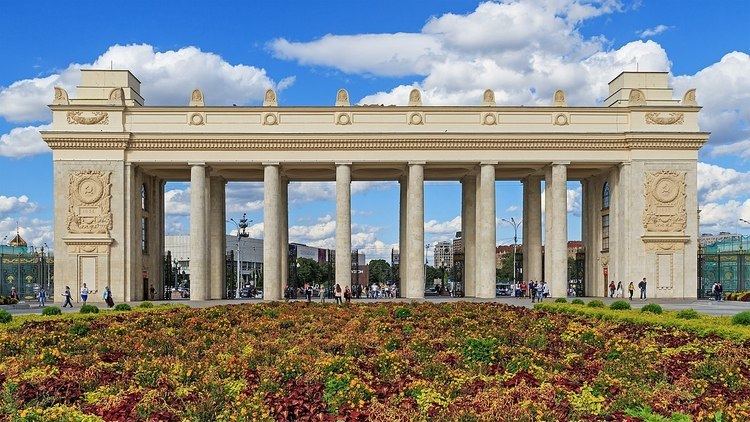Area 121 ha Phone +7 495 995-00-20 | Opened 12 August 1928 | |
 | ||
Address Krimsky Val, 9, Moskva, Russia, 119049 Hours Open today · Open 24 hoursFridayOpen 24 hoursSaturdayOpen 24 hoursSundayOpen 24 hoursMondayOpen 24 hoursTuesdayOpen 24 hoursWednesdayOpen 24 hoursThursdayOpen 24 hours Similar Fallen Monument Park, VDNKh, Sokolniki Park, Tretyakov Gallery, Neskuchny Garden Profiles | ||
Gorky Central Park of Culture and Leisure (Russian: Центральный парк культуры и отдыха (ЦПКиО) имени Горького , Tsentralny park kultury i otdykha imeni Gorkogo; [tsɨnˈtralʲnɨj ˈpark kʊlʲˈturɨ i ˈoddɨxə ˈimɪnɪ ˈɡorkova]) is a central park in Moscow, named after Maxim Gorky.
Contents
History
Gorky Park, located at Krymsky Val and situated just across the Moskva River from Park Kultury Metro station, opened in 1928. The park followed the plan of Konstantin Melnikov, a world-famous Soviet avant-garde and constructivist architect, and amalgamated the extensive gardens of the old Golitsyn Hospital and of the Neskuchny Palace, covering an area of 300 acres (120 ha) along the river. The history of the Neskuchny Garden can be traced back to 1753, when it emerged in the area between Kaluzhskaya Zastava and Trubetskoy Moskva river-side estate. The neighboring area to Neskuchny Garden, from Krymsky Val to Neskuchny Garden, received little attention right up until the 1920s. Initially it was covered with park gardens, meadows and vegetable gardens belonging to the owners of neighboring estates. It formed a wasteland by the end of the 19th century, and served as a waste heap.
The First All-Russian Agricultural and Handicraft Industries Exhibition opened in 1923 on the wasteland that had been cleared during the course of communist community work=days. A resolution for the exhibition was passed on 19 October 1922 and the exhibition opened one and a half years later on 19 May 1923. After bidding for the exhibition's layout plan, which proposed four arrangements — Sokol, Khodynskoye Pole, Petrovsko-Razumovsky park and the river areas near Krymsky bridge — preference was given to the last option.
On 15 March 1928 by a resolution of the Presidium of the Moscow Council, the Agricultural and Handicraft Industries Exhibition was enlarged and transformed into the Central Park of Culture and Leisure — the country’s first park of its kind, which was referred to as an outdoor "cultural enterprise". The name of M.A. Gorky was attributed to the park in 1932. The idea of a need for a central park of culture and leisure in Moscow arose in the late 1920s in relation to Moscow's reconstruction with notions of a socialist "city of the future".
Gorky Park has always reflected the spirit of its times and social values. At the end of 20th century, concentration on sport - in the best tradition of the Soviet era - retreated in the face of the commercial post-perestroika mood. The time of amusement attractions, numerous small shashlik cafes, advertising banners and entrance-fees had begun. Nevertheless, the Park remained beloved by the people for its shadowed alleys. During the winter the footpaths flood over and freeze, which allows ice-skating around the park. Over the years the rides became decrepit, and the park territory was swamped with cheap attractions and cafes. The new 21st century brought a new wind of change and the need to transform the Park's concept.
Transformation
In 2011 Gorky Park underwent a major reconstruction. New director of Central Park of Culture and Leisure Sergei Kapkov demolished approximately 100 attractions and illegal objects. More than two thousand square meters of new asphalt roadbed was laid on the site of demolished objects and 1.9 ha of new lawns and flowerbeds were laid out. All amusement rides but one, a two deck carousel, have been removed in order to transform the place into an eco-friendly recreational zone. Free entry, Wi-Fi coverage, new zones of contemporary design, a well thought-out events program have transformed Gorky Park into one of the epicenters of life in the capital. In order to create something new, it was necessary to clean the park of abandoned buildings, carts, tents, advertising structures and attractions. Renovation of monuments, cleaning the ponds and delivering soil and grass turf started. Gorky Park was transformed in several months, becoming the first Russian park that could now compete with the leading parks of the world. A 15,000 square meter ice rink, with separate zones for children, hockey, dancing, and general skating, was officially opened in December 2011.
Shortly after he took over the park, Sergei Kapkov was appointed to the role Moscow Government Minister and Head of the Department of Cultural Heritage. Olga Zakharova had replaced Sergei Kapkov and has been holding the position ever since.
